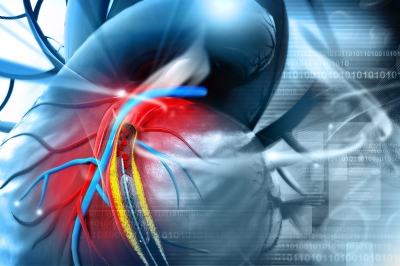Stent Procedure to Treat Coronary Artery Disease
 Over the past 20 years, treatment options for coronary artery disease (CAD) has become much more effective and commonplace. This often leads patients to ask fewer questions about treatment options, advances, and benefits. Instead, questions focus on monetary cost and logistics of the planned procedure versus how quickly they will return to normal daily activities.
Over the past 20 years, treatment options for coronary artery disease (CAD) has become much more effective and commonplace. This often leads patients to ask fewer questions about treatment options, advances, and benefits. Instead, questions focus on monetary cost and logistics of the planned procedure versus how quickly they will return to normal daily activities.
A stent procedure is one frequently used treatment option for CAD. When plaque builds up inside an artery, blood flow to the heart can be compromised. The blockage leads to coronary artery disease and can result in chest pain and a heart attack.
Most stents are tiny wire mesh tubes placed within an artery to help keep it open and blood flowing as needed. A medicine coating on the stents is slowly released to prevent re-blockage of the artery.
A conversation with a stent patient and cardiologist
Knowing the right questions to ask proved to be of special significance for CAD patient Shawna Dukes. A combination of active research and persistence with doctors enabled Shawna to ask the right questions, which ultimately saved her life. After consulting with a number of physicians who could not determine the cause of her extreme fatigue and overall discomfort, she finally found answers from her interventional cardiologist. He determined that getting a stent that promotes faster healing was the right treatment option for her, and one that gave her back control of her health again.
Shawna and her interventional cardiologist, Dr. Colin Barker, took the time to answer a few questions regarding her situation and results.
Lisa Nelson RD: Shawn, please tell us about your heart condition and how your personal research led to a diagnosis and treatment plath?
Shawna Dukes: I’m a very active person. I live a very active lifestyle. Several months ago, out of the blue while I was doing one of those activities of working out, I had troubling symptoms of throat and neck tightness. I had chest tightness on my left side. I had numbness that ran down my left arm.
They were symptoms that I had never experienced before. It definitely got my attention. Over the next several weeks, I had them again and again. It led me to my primary care doctor. Through him and a couple more doctors, and about ten diagnostic tests along the way, I was told I had coronary artery disease and angina. I was given medication for that.
But it limited my lifestyle. I couldn’t do the things I was doing before without those symptoms flaring up. I really didn’t think that was my best solution. It didn’t sit well with me, that this was going to be my new normal. With my symptoms that kept breaking through, even when I was on medication, on a particular day when they were very severe, I thought, “I really need to seek someone else. I need to get an answer from someone else.”
That led me to Dr. Barker. The day that I had the very severe symptoms, he saw me. Finally, I learned the cause of it. It was the 90% blockage of a major artery of my heart. That day, he had me in the cath lab. He performed a procedure to implant a stent. It’s the SYNERGY stent that I received. Within minutes, I felt better. A few weeks later, I was back to my very active lifestyle of working out every day and walking a couple of miles with my dog. It just restored my life and gave it back to me.
Choline and Memory
I previously shared some information on the potential link between choline and coronary artery disease. Here’s a little more info on choline you may find useful:
Acetylcholine and lecithin are derived from the B vitamin choline. Acetylcholine may protect against some forms of age related dementia. In the early 1970’s and 1980’s, abnormal uptake of acetylcholine, synthesis, and release was identified in individuals with Alzheimer’s and Parkinson’s disease. However, there has been a lacks of strong experimental support to validate these findings in recent years.
All the best,
Lisa Nelson RD
How to Lower Cholesterol in 8 Simple Steps
https://lisanelsonrd.com/howtolowercholesterol.html
Heart Disease and the B Vitamin Choline
A proposed link between the B vitamin choline and coronary artery disease is being explored. The relationship between choline and coronary artery disease (CAD) may involve the accumulation of homocysteine and the effect these concentrated homocysteine levels have on endothelial cells (inner layer of blood vessels).
Several studies indicate that homocysteine levels are a key contributor and primary risk factor for CAD. While on the flip side, several studies have shown no decreased CAD risk with a reduction in homocysteine levels.
So, the importance of choline in reducing the risk of coronary artery disease is debatable. Regardless, choline plays important roles in metabolism and normal cell function, so it’s worth knowing a little about this B vitamin.



